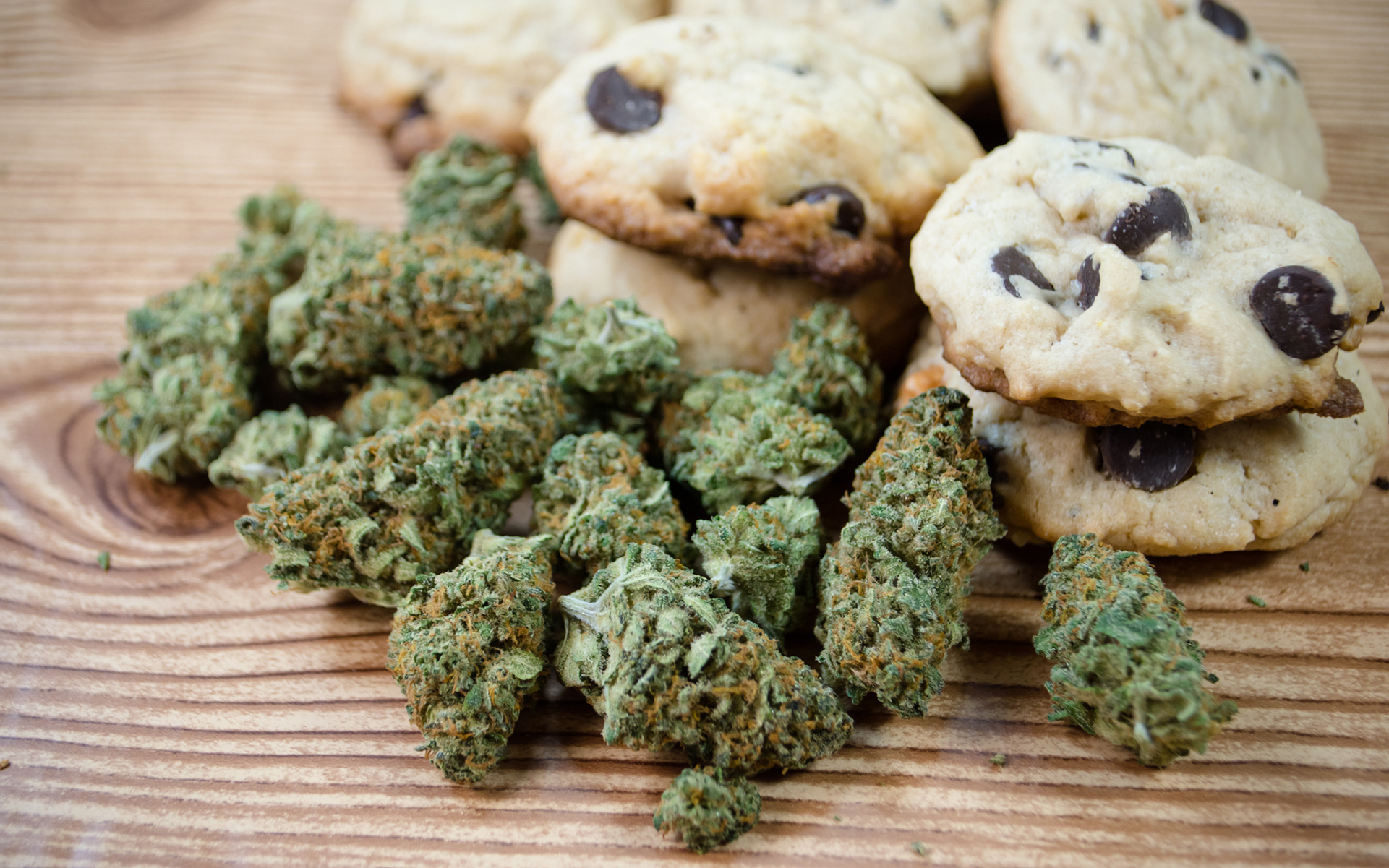
{window.LeaflyInternalAdPlacer.triggerAd({"unit":"/13212770/news/news_upper","sizes":{"1026,0":"728,90","0,0":["320,50","300,250"]},"additional_classes":"top","div_id":"leafly-green--programmatic-ad--news-article-programmatic-first--0684665001605716679-5","tracking":{"news-slug":"cannabis-edibles-dosage-guide-chart","news-category":"cannabis-101","news-tags":"dosing,edibles"}});});]]>
Edible forms of cannabis, including food products, lozenges, and capsules, can produce effective, long-lasting, and safe effects. These forms of cannabis are also most likely to produce unwanted effects and overconsumption symptoms, which can be very unpleasant. The difference is, of course, the dose.
Here, you’ll find a chart that describes typical effects felt at different ingested doses. However, there are factors to consider when choosing the right dose for you, which you can read more about below.
Order cannabis products online with Leafly Pickup or Delivery
Created in conjunction with Healer.com; for more information visit: www.healer.com/programs
The right edible dose varies between individuals
Every person has a unique internal physiologic environment and can therefore experience different results with various medications. One person’s response to a dose of edible cannabis can vary significantly from the next, even more so than other medications or herbs. Why?
Several factors are involved, including previous history of cannabis use, gastrointestinal factors, and the function/sensitivity of one’s endocannabinoid system. Approximately 3% of my patients are ultra-sensitive to THC and do well with very low doses (e.g., 1 mg).
Once you go above 100 mg and into extremely high dosages such as 150 mg, 200 mg, or even 500 mg marijuana edibles, the risk of negative effects associated with the idea of overconsuming cannabis—such as nausea and paranoia—increase, even for consumers who may have very high tolerances.
How many mg of edibles should you eat?
The ideal edibles dose depends on a lot of things, including tolerance, individual body chemistry, and the experience you’re looking for. But there are some basic guidelines that can help you find the right dose of marijuana edibles, which are measured in milligrams (mg).
1 – 2.5 mg THC edibles
- Effects include: Mild relief of symptoms like pain, stress, and anxiety; increased focus and creativity.
- Good for: First-time consumers or regular consumers looking to microdose.
2.5 – 15 mg THC edibles
- Effects include: Stronger relief of pain and anxiety symptoms; euphoria; impaired coordination and perception.
- Good for: Standard recreational use; persistent symptoms not addressed by smaller doses; people looking for a good night’s sleep.
30 – 50 mg THC edibles
- Effects include: Strong euphoric effects; significantly impaired coordination and perception.
- Good for: High tolerance THC consumers; consumers whose GI systems don’t absorb cannabinoids well.
50 – 100 mg THC edibles
- Effects include: Seriously impaired coordination and perception; possible unpleasant side effects including nausea, pain, and increased heart rate.
- Good for: Experienced, high-tolerance THC consumers; patients living with inflammatory disorders, cancer, and other serious conditions.
How long does it take to feel an effect from edibles?
The most common mistake in cannabis dosing occurs when a person doesn’t feel any effect from an edible after one hour and decides to take another dose; two hours later, both doses come through and the individual experiences the unpleasant effects of a cannabis overconsumption.
If you’re unsure if a particular dose of cannabis is affecting you, I recommend learning Healer’s “inner inventory,” a fast and simple self-awareness tool that can be used to determine if you’re feeling the effects of a particular dose of cannabis. For strategies to methodically increase your dose of cannabis to achieve optimal results, see Healer.com/programs.
Understand the effects of CBD and THC content in edibles
Adding CBD to THC can enhance the medical benefits of marijuana edibles, such as pain or anxiety relief, while decreasing the adverse effects, such as impairment and elevated heart rate.
CBD partially blocks the intoxicating effects of THC, so consumers who wish to experience the medical benefits of cannabis without as much impairment can best achieve this with products that contain both CBD and THC. It’s important for consumers to know the contents of each of these components and the ratio of CBD to THC.
Products with a CBD:THC ratio of 1:1 are powerfully therapeutic and produce less impairment than a THC-dominant product. Excessive doses of these products can still produce classic cannabis overconsumption symptoms.
As the CBD:THC ratio increases, the likelihood of unwanted intoxicating effects decreases, and the quality of the medical effects will also change. At a 4:1 ratio or higher, adverse intoxicating effects are unlikely unless one takes a very high dose.
For example, a person who feels impaired after taking 5 mg of THC will likely feel less or no impairment when taking 20 mg of CBD + 5 mg of THC.
More tips for consuming cannabis-infused edibles
- If you don’t feel any effects from an edible after one hour, try eating a snack like an organic apple to turn on the digestion and absorption in your gut.
- Some people who are new to cannabis require 2-3 doses before they feel anything at all, so it’s often best to try the same low dose three times with 8 to 24 hours between trials before increasing the dose.
- I’ve infrequently met patients who seem unable to absorb any significant amount of THC through the gut. In these individuals, absorption via the oral blood vessels (i.e., under your tongue) or the lungs is the best option.
Tips for relieving overconsumption of edibles
- Be in a calm, safe environment and have gentle reassurance that everything will be OK is the primary treatment.
- Stay hydrated.
- A large 50-200mg dose of CBD (without significant amounts of THC) can act as a partial antidote. Lemon oil, found predominantly in the rind and in lower amounts in the juice, has also been used historically for this purpose. Grate a tablespoon of lemon zest and chew it up before swallowing.
- Most people do not need emergency medical care unless they have pre-existing heart disease or another serious medical condition. For ongoing vomiting and diarrhea, intravenous rehydration may be necessary.
This post was originally published on April 19, 2018. It was most recently updated on March 2, 2020.

Dr. Dustin Sulak
Dustin Sulak, DO, is the founder of Integr8 Health, a medical practice in Maine that follows over 8,000 patients using medical cannabis; Healer.com, a medical cannabis patient education resource; and Cannabis Expertise, a continuing medical education curriculum. Recognized as a leading clinician in the application of medical cannabis, Dr. Sulak is committed to providing education to clinicians and patients on the use of medical cannabis.
View Dr. Dustin Sulak's articles {window.LeaflyInternalAdPlacer.triggerAd({"unit":"/13212770/news/news_lower","sizes":{"1026,0":"728,90","0,0":["320,50","300,250"]},"additional_classes":"bottom","div_id":"leafly-green--programmatic-ad--news-article-programmatic-last--0687276001605716679-6","tracking":{"news-slug":"cannabis-edibles-dosage-guide-chart","news-category":"cannabis-101","news-tags":"dosing,edibles"}});});]]>
By submitting this form, you will be subscribed to news and promotional emails from Leafly and you agree to Leafly's Terms of Service and Privacy Policy. You can unsubscribe from Leafly email messages anytime.